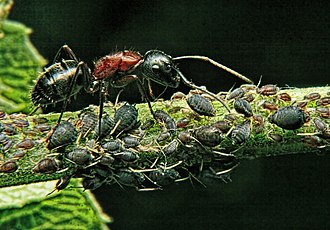Mutualism is defined as a reciprocally beneficial relationship between at least two different species. Generally, these relations only occur when the costs of interspecific interaction are outweighed by their benefits (Stadler and Dixon, 2005). Such interactions, generally are facilitated by mechanisms, such as chemical communication, and have resulted in widespread coevolution. In fact, these interactions, particularly amongst pollinators, are often attributed in increasing biodiversity.
The most ubiquitous example of mutualist interactions is between the ants and aphids (Styrsky and Eubanks, 2006). Both species provide the other with immense fitness benefits. Aphids produce honeydew, which are highly reliable food sources for ants, due to their richness in water and carbohydrates. The production of honeydew attracts ants, who in return, provide aphids with sanitization services and protection from predators.
As such, mutualistic interacts are sustained when a particular action of either species produces an increase in fitness in both partners (Orona-Tamayo and Heil, 2013). The trail pheromone deposited by ant workers while foraging food, stabilizes the mutualistic relation between aphids and ants. These trails are produced by ants to allow nestmates to follow. However, the role of these semiochemicals in ant-aphid interactions is not properly understood. Research has predominantly focused on the semiochemicals produced by aphids and how they regulate ant behaviour.

Crude Hexane is used for Communication!
This study hypothesized that the semiochemicals of red-imported fire ants (RIFA) (Solenopsis invicta) perpetuated a mutualistic relation with Cotton Aphids (Aphis gossypii). Particularly, the study focused on the influence of crude hexane extracts produced by RIFA workers on cotton aphid behaviour and ecology. Additionally, the impact of seven fraction of the hexane extract on cotton aphids, were also studied independently. These fractions, which were extracted using silica gel column chromatography, include FTP, FCA, FTA, FCHC, F2, F4 and F6.
A prominent result from the study was that RIFA semiochemicals supressed the dispersal of the apterous. The dispersal time of aphids from the centre to the edge of a petri of dish was measured. There was a substantial increase in dispersal time when the aphids were exposed to the semiochemicals in the filter paper compared to the control solvent. However, amongst the seven individual fractions, only FTP significantly increased dispersal time.
What is Electroantennography?
The study also examined the antennal response of the aphids to all seven fractions using electroantennography (EAG). This process estimates the average output of an insect antenna to its brain for any particular odour. The process is conducted by attaching one electrode of a ground wire to an eye of the insect. This is the reference electrode. The reference electrode of the EAG was attached to the Aphid’s eye while the recording electrode was attached the antenna.
An EAG was conducted for two doses – 50 and 500ng – of each fraction. As such FTP had a far larger EAG response than the other six fractions. Consistent to the results of dispersal time, FTP induced results similar to the extract as a whole. The antennal response of the four compounds found which FTP consists were also individually studied.
The Impact of Ant Pheromones on Aphid Demographics
The study also attempted to investigate the temporal changes in aphid population sizes on cotton seedlings when exposed to different pheromone compounds. Only FTP and ZEF elevated population growth on seedlings compared to the solvent, hence producing a larger population of aphids. Other studies have also found that when tended by RIFA, the population growth of cotton aphids is attenuated (Rice and Eubanks, 2013).
This suggests that mutualistic relations are highly beneficials for cotton aphids, which subsequently benefits RIFA with elevated quantities of carbohydrates. These have significant implications as large populations of cotton aphids negatively impact cotton yields (Kaplan and Eubanks, 2002). Particularly, the establishment of mutualistic interactions with invasive RIFA in South-eastern USA has resulted in an outbreak of cotton aphids, resulting in significant agricultural loses (Kaplan and Eubanks, 2002).This study provides a profound insight to the underlying mechanism into one of the most prominent example of mutualism.
Help us Help Them! Think Wildlife Foundation is a non profit organization with various conservation initiatives. Our most prominent campaign is our Caring for Pari intiative. Pari is a rehabilitated elephant at the Wildlife SoS Hospital. 25% of the profits from our store are donated to the elephant hospital for Pari. Other than buying our wonderful merchandise, you could donate directly to our Caring For Pari fundraiser.
References
Kaplan, I. and Eubanks, M., 2002. Disruption of Cotton Aphid (Homoptera: Aphididae)—Natural Enemy Dynamics by Red Imported Fire Ants (Hymenoptera: Formicidae). Environmental Entomology, 31(6), pp.1175-1183.
Oliver, T., Mashanova, A., Leather, S., Cook, J. and Jansen, V., 2007. Ant semiochemicals limit apterous aphid dispersal. Proceedings of the Royal Society B: Biological Sciences, 274(1629), pp.3127-3131.
Orona-Tamayo, D. and Heil, M., 2013. Stabilizing Mutualisms Threatened by Exploiters: New Insights from Ant-Plant Research. Biotropica, 45(6), pp.654-665.
Rice, K. and Eubanks, M., 2013. No Enemies Needed: Cotton Aphids (Hemiptera: Aphididae) Directly Benefit from Red Imported Fire Ant (Hymenoptera: Formicidae) Tending. Florida Entomologist, 96(3), pp.929-932.
Stadler, B. and Dixon, A., 2005. Ecology and Evolution of Aphid-Ant Interactions. Annual Review of Ecology, Evolution, and Systematics, [online] 36(1), pp.345-372. Available at: <https://www.annualreviews.org/doi/abs/10.1146/annurev.ecolsys.36.091704.175531> [Accessed 22 November 2021].
Styrsky, J. and Eubanks, M., 2006. Ecological consequences of interactions between ants and honeydew-producing insects. Proceedings of the Royal Society B: Biological Sciences, 274(1607), pp.151-164.
